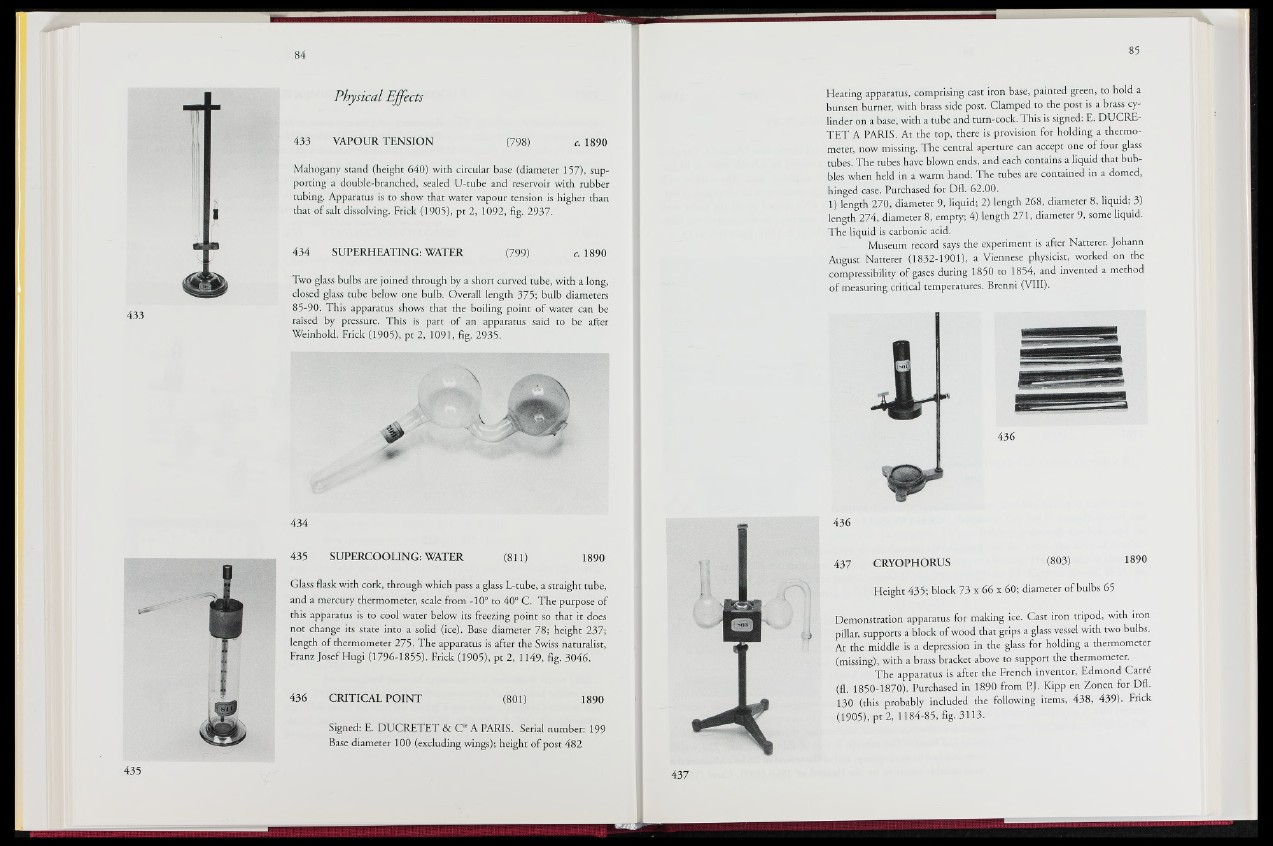
Physical Effects
433 VAPOUR TENSION (798) c. 1890
Mahogany stand (height 640) with circular base (diameter 1 5 » supporting
a double-branched, sealed U-tube and reservoir with rubber
tubing. Apparatus is to show that water vapour tension is higher than
that of salt dissolving. Frick (1905), pt 2, 1092, fig. 2937.
434 SUPERHEATING: WATER j§99) c. 1890
Two glass bulbs are joined through by a short curved tube, with a long,
closed glass tube below one bulb. Overall length 375; bulb diameters
85-90. This apparatus shows that the boiling point of water can be
raised by pressure. This is part of an apparatus said to be after
Weinhold. Frick (1905), pt 2, 1091, fig. 2935.
434
435 SUPERCOOLING: WATER (811) 1890
Glass flask with cork, through which pass a glass L-tube, a straight tube,
and a mercury thermometer, scale from -10° to 40° C. The purpose of
this apparatus is to cool water below its freezing point so that it does
not change its state into a solid (ice). Base diameter 78; height 237;
length of thermometer 275. The apparatus is after the Swiss naturalist,
Franz Josef Hugi (1796-1855). Frick (1905), pt 2, 1149, fig. 3046.
436 CRITICAL POINT (801) 1890
Signed: E. DUCRE^jg|'& C 'A PARIS. Serial number: 199
Base diameter 100 (excluding wings); height of post 482
Heating apparatus, comprising cast iron base, painted green, to hold a
bunsen burner, with brass side post. Clamped to the post is a brass cylinder
on a base, with a tube and turn-cock. This is signed: E. DUCRE-
TET A PARIS. At the top, there is provision for holding a thermometer,
now missing. The central aperture can accept one of four glass
tubes. The tubes have blown ends, and each contains a liquid that bubbles
when held in a warm hand. The tubes are contained in a domed,
hinged case. Purchased for Dfl. 62.00.
1) length 270, diameter 9, liquid; 2) length 268, diameter 8, liquid; 3)
length 2|j |, diameter 8, empty;:;#) length 271, diameter 9, some liquid.
The liquid is carbonic acid.
Museum record says the experiment is after Natterer. Johann
August Natterer (1832-1901), a Viennese physicist, worked on the
compressibility of gases during 1850 to 1854, and invented a method
of measuring critical temperatures. Brenni (VIII).
437 CRYOPHORUS (803) 1890
Height 435; block 73 x 66 x 60; diameter of bulbs 65
Demonstration apparatus for making ice. Cast iron tripod, with iron
p i l la r , supports a block of wood that grips a glass vessel with two bulbs.
At the middle is a depression in the glass for holding a thermometer
(missing), with a brass bracket above to support the thermometer.
The apparatus is after the French inventor, Edmond Carre
H*1850-1870). Purchased in 1890 from P.J. Kipp en Zonen for Dfl.
130 (this probably included the following items, 438, 439). -Frick
11905), pt 2, 1184-85, fig. 3113.